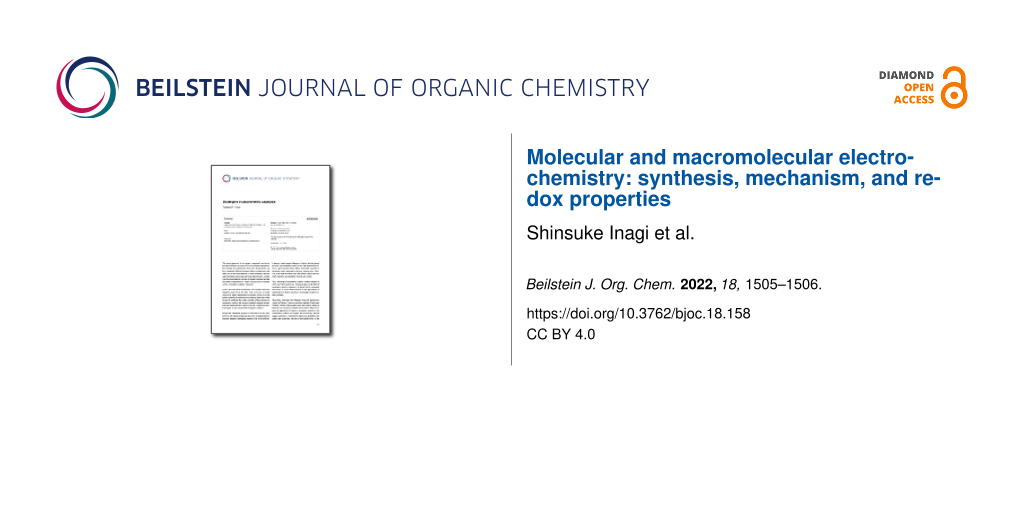Electrochemistry is now a powerful tool in organic chemistry not only for analyzing the electron transfer behavior of organic molecules and macromolecules, but also for driving organic reactions to produce value-added products. Electrochemical synthesis (or simply electrosynthesis) is increasingly recognized for the high academic and industrial importance, in line with the concept of green chemistry proposed in 1998 and the Sustainable Development Goals (SDGs) adopted by the United Nations in 2015. This is evidenced by the recent publication of special issues on organic electrosynthesis in various academic journals [1-5].
In addition to the conventional two- or three-electrode batch-type electrolytic cells, recent developments include microflow electrolytic reactors, polymer electrolyte membrane electrolysis technology, and new methods coupled with photoredox catalysts or transition metal catalysis, resulting in remarkable progress in organic electrosynthetic processes. Theoretical calculations have also led to a better understanding of the electron transfer behavior of organic molecules and the estimation of subsequent reactions, resulting in a much better understanding of the reaction mechanism. Furthermore, because organic electrosynthesis requires the setting of many complex parameters, such as applied potential, current density, electrolyte, temperature, and so on, it has a high affinity to informatics approaches, e.g., machine learning, which is expected to become an increasingly important tool in the future.
Progress in the design of organic molecules and polymers and the understanding of the redox behavior of these compounds has led to the development of organic electrochemistry for energy material applications. Organic semiconductor design for electron or hole transport is important for transistor and solar cell applications, and redox-active (but stable) organic and polymeric materials are promising for secondary batteries and redox flow batteries. By understanding organic electron transfer reactions, we can face the challenge of how to design materials with better cycle properties by suppressing undesired side reactions.
To showcase this area of research, the present thematic issue focuses on the recent advances in molecular and macromolecular electrochemistry. The scope of this interdisciplinary issue ranges from synthetic aspects (such as electrosynthesis and reaction mechanisms) to materials science (including redox properties and devices).
Shinsuke Inagi and Mahito Atobe
Yokohama, October 2022
References
-
Waldvogel, S. R. Beilstein J. Org. Chem. 2015, 11, 949–950. doi:10.3762/bjoc.11.105
Return to citation in text: [1] -
Francke, R.; Little, R. D.; Inagi, S. ChemElectroChem 2019, 6, 4065–4066. doi:10.1002/celc.201901175
Return to citation in text: [1] -
Little, R. D.; Moeller, K. D. Chem. Rev. 2018, 118, 4483–4484. doi:10.1021/acs.chemrev.8b00197
Return to citation in text: [1] -
Minteer, S. D.; Baran, P. Acc. Chem. Res. 2020, 53, 545–546. doi:10.1021/acs.accounts.0c00049
Return to citation in text: [1] -
Fuchigami, T. Chem. Rec. 2021, 21, 2079. doi:10.1002/tcr.202100232
Return to citation in text: [1]
| 1. | Waldvogel, S. R. Beilstein J. Org. Chem. 2015, 11, 949–950. doi:10.3762/bjoc.11.105 |
| 2. | Francke, R.; Little, R. D.; Inagi, S. ChemElectroChem 2019, 6, 4065–4066. doi:10.1002/celc.201901175 |
| 3. | Little, R. D.; Moeller, K. D. Chem. Rev. 2018, 118, 4483–4484. doi:10.1021/acs.chemrev.8b00197 |
| 4. | Minteer, S. D.; Baran, P. Acc. Chem. Res. 2020, 53, 545–546. doi:10.1021/acs.accounts.0c00049 |
| 5. | Fuchigami, T. Chem. Rec. 2021, 21, 2079. doi:10.1002/tcr.202100232 |
© 2022 Inagi and Atobe; licensee Beilstein-Institut.
This is an open access article licensed under the terms of the Beilstein-Institut Open Access License Agreement (https://www.beilstein-journals.org/bjoc/terms), which is identical to the Creative Commons Attribution 4.0 International License (https://creativecommons.org/licenses/by/4.0). The reuse of material under this license requires that the author(s), source and license are credited. Third-party material in this article could be subject to other licenses (typically indicated in the credit line), and in this case, users are required to obtain permission from the license holder to reuse the material.









